北师大版(2019)必修第二册 Unit4 Information technology Lesson 2 Apps & Lesson 3 Internet 课后练(含答案)
文档属性
| 名称 | 北师大版(2019)必修第二册 Unit4 Information technology Lesson 2 Apps & Lesson 3 Internet 课后练(含答案) | 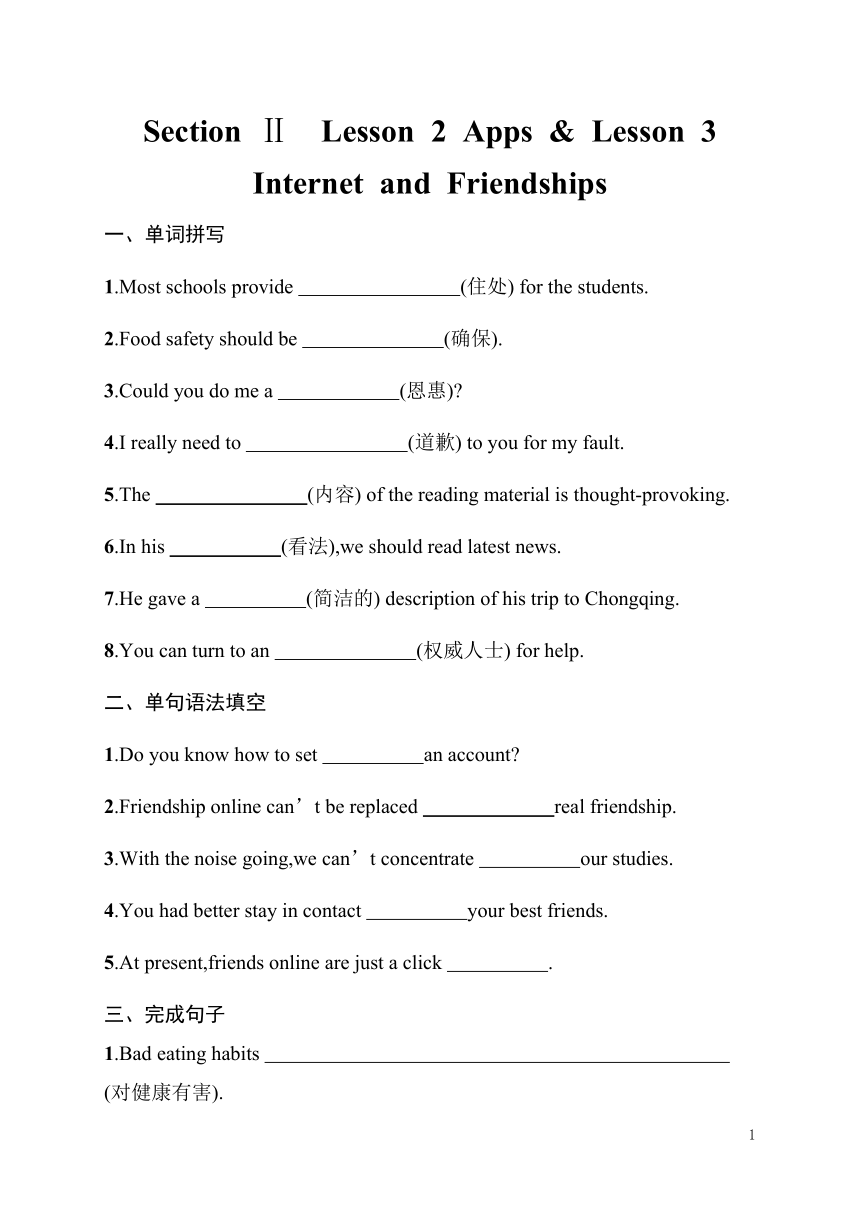 | |
| 格式 | docx | ||
| 文件大小 | 36.0KB | ||
| 资源类型 | 教案 | ||
| 版本资源 | 北师大版(2019) | ||
| 科目 | 英语 | ||
| 更新时间 | 2023-07-10 21:18:30 | ||
图片预览

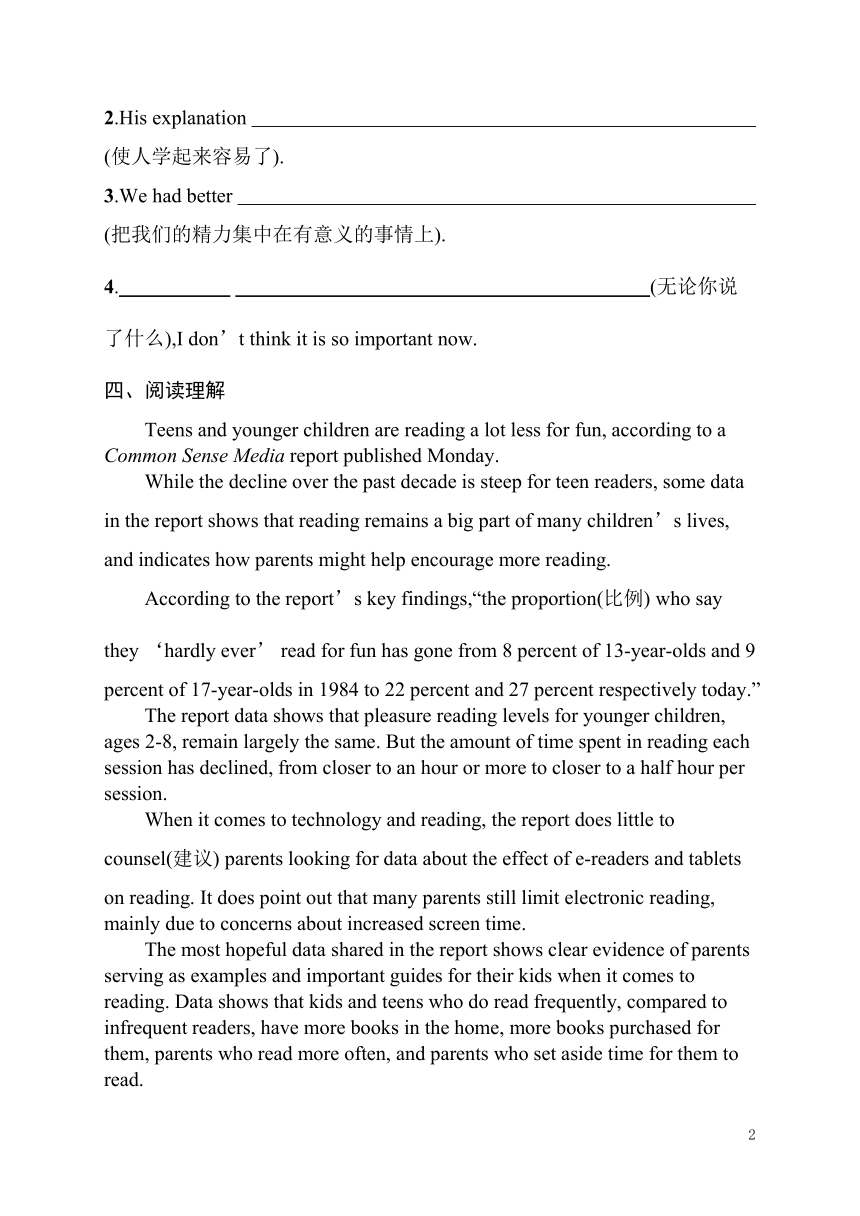
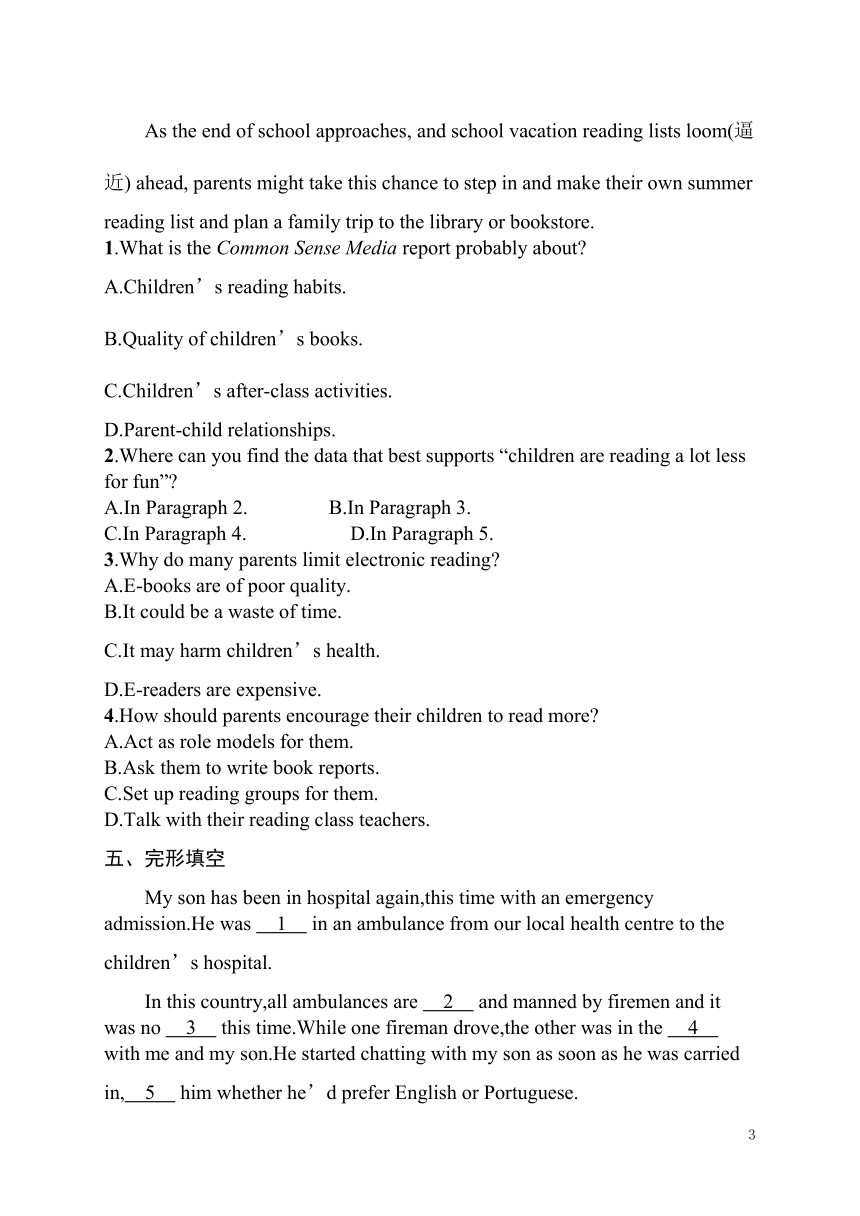
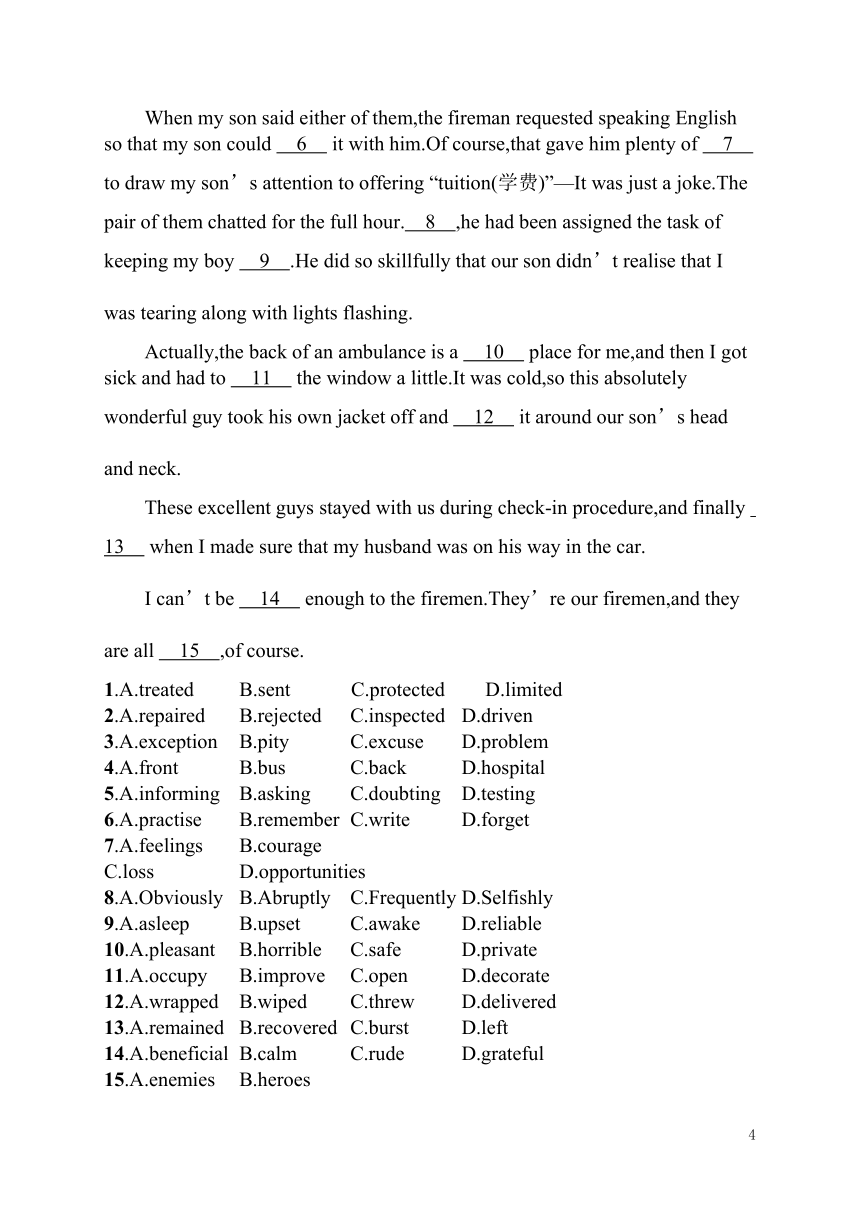
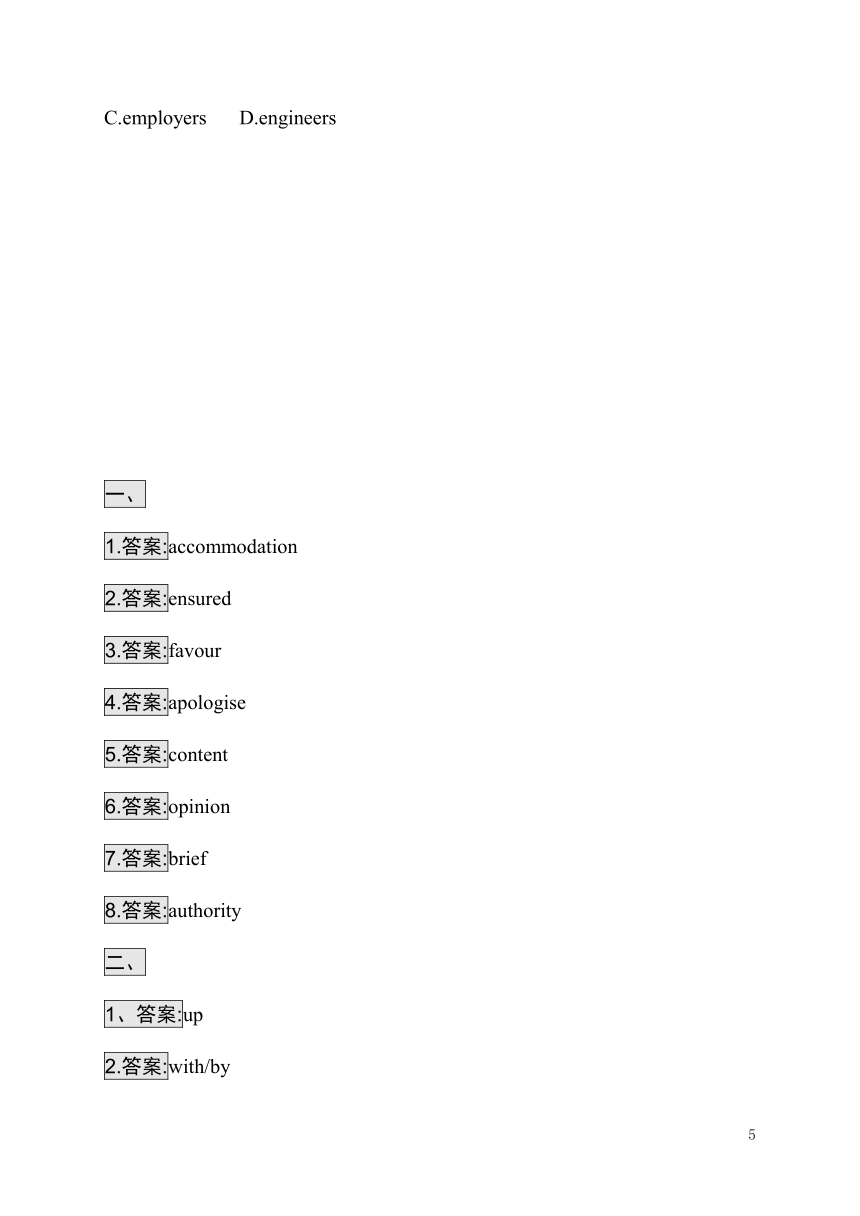
文档简介
Section Ⅱ Lesson 2 Apps & Lesson 3 Internet and Friendships
一、单词拼写
1.Most schools provide (住处) for the students.
2.Food safety should be (确保).
3.Could you do me a (恩惠)
4.I really need to (道歉) to you for my fault.
5.The (内容) of the reading material is thought-provoking.
6.In his (看法),we should read latest news.
7.He gave a (简洁的) description of his trip to Chongqing.
8.You can turn to an (权威人士) for help.
二、单句语法填空
1.Do you know how to set an account
2.Friendship online can’t be replaced real friendship.
3.With the noise going,we can’t concentrate our studies.
4.You had better stay in contact your best friends.
5.At present,friends online are just a click .
三、完成句子
1.Bad eating habits (对健康有害).
2.His explanation (使人学起来容易了).
3.We had better (把我们的精力集中在有意义的事情上).
4. (无论你说了什么),I don’t think it is so important now.
四、阅读理解
Teens and younger children are reading a lot less for fun, according to a Common Sense Media report published Monday.
While the decline over the past decade is steep for teen readers, some data in the report shows that reading remains a big part of many children’s lives, and indicates how parents might help encourage more reading.
According to the report’s key findings,“the proportion(比例) who say they ‘hardly ever’ read for fun has gone from 8 percent of 13-year-olds and 9 percent of 17-year-olds in 1984 to 22 percent and 27 percent respectively today.”
The report data shows that pleasure reading levels for younger children, ages 2-8, remain largely the same. But the amount of time spent in reading each session has declined, from closer to an hour or more to closer to a half hour per session.
When it comes to technology and reading, the report does little to counsel(建议) parents looking for data about the effect of e-readers and tablets on reading. It does point out that many parents still limit electronic reading, mainly due to concerns about increased screen time.
The most hopeful data shared in the report shows clear evidence of parents serving as examples and important guides for their kids when it comes to reading. Data shows that kids and teens who do read frequently, compared to infrequent readers, have more books in the home, more books purchased for them, parents who read more often, and parents who set aside time for them to read.
As the end of school approaches, and school vacation reading lists loom(逼近) ahead, parents might take this chance to step in and make their own summer reading list and plan a family trip to the library or bookstore.
1.What is the Common Sense Media report probably about
A.Children’s reading habits.
B.Quality of children’s books.
C.Children’s after-class activities.
D.Parent-child relationships.
2.Where can you find the data that best supports “children are reading a lot less for fun”
A.In Paragraph 2. B.In Paragraph 3.
C.In Paragraph 4. D.In Paragraph 5.
3.Why do many parents limit electronic reading
A.E-books are of poor quality.
B.It could be a waste of time.
C.It may harm children’s health.
D.E-readers are expensive.
4.How should parents encourage their children to read more
A.Act as role models for them.
B.Ask them to write book reports.
C.Set up reading groups for them.
D.Talk with their reading class teachers.
五、完形填空
My son has been in hospital again,this time with an emergency admission.He was 1 in an ambulance from our local health centre to the children’s hospital.
In this country,all ambulances are 2 and manned by firemen and it was no 3 this time.While one fireman drove,the other was in the 4 with me and my son.He started chatting with my son as soon as he was carried in, 5 him whether he’d prefer English or Portuguese.
When my son said either of them,the fireman requested speaking English so that my son could 6 it with him.Of course,that gave him plenty of 7 to draw my son’s attention to offering “tuition(学费)”—It was just a joke.The pair of them chatted for the full hour. 8 ,he had been assigned the task of keeping my boy 9 .He did so skillfully that our son didn’t realise that I was tearing along with lights flashing.
Actually,the back of an ambulance is a 10 place for me,and then I got sick and had to 11 the window a little.It was cold,so this absolutely wonderful guy took his own jacket off and 12 it around our son’s head and neck.
These excellent guys stayed with us during check-in procedure,and finally 13 when I made sure that my husband was on his way in the car.
I can’t be 14 enough to the firemen.They’re our firemen,and they are all 15 ,of course.
1.A.treated B.sent C.protected D.limited
2.A.repaired B.rejected C.inspected D.driven
3.A.exception B.pity C.excuse D.problem
4.A.front B.bus C.back D.hospital
5.A.informing B.asking C.doubting D.testing
6.A.practise B.remember C.write D.forget
7.A.feelings B.courage
C.loss D.opportunities
8.A.Obviously B.Abruptly C.Frequently D.Selfishly
9.A.asleep B.upset C.awake D.reliable
10.A.pleasant B.horrible C.safe D.private
11.A.occupy B.improve C.open D.decorate
12.A.wrapped B.wiped C.threw D.delivered
13.A.remained B.recovered C.burst D.left
14.A.beneficial B.calm C.rude D.grateful
15.A.enemies B.heroes
C.employers D.engineers
一、
1.答案:accommodation
2.答案:ensured
3.答案:favour
4.答案:apologise
5.答案:content
6.答案:opinion
7.答案:brief
8.答案:authority
二、
1、答案:up
2.答案:with/by
3.答案:on
4.答案:with
5.答案:away
三、
1.答案:do harm to/are harmful to health
2.答案:makes people easy to learn
3.答案:concentrate/focus our energy on meaningful things
4.答案:No matter what you’ve said
四、
1.答案:A
解析:推理判断题。根据文章第一段中的“Teens and younger children are reading a lot less for fun”可知, 青少年与年龄更小的孩子们读书的乐趣要少得多, 这正是孩子们的阅读习惯问题, 故选A项。B项“儿童书籍的质量”, C项“孩子们的课后活动”, D项“亲子关系”, 均与题意不符。
2.答案:B
解析:细节理解题。根据文章第三段的内容可知, 几乎从没有以读书为乐的比例, 从1984年8%的13岁儿童和9%的17岁儿童分别上升到了今天的22%和27%。因此, 第三段的内容是“children are reading a lot less for fun”的最好的佐证。故选B项。
3.答案:C
解析:细节理解题。根据文章第五段最后一句中的“mainly due to concerns about increased screen time”可知, 许多家长限制孩子们电子阅读的时间, 主要是因为担心孩子们看电子屏幕的时间增加, 不利于孩子们的健康。故选C项。
4.答案:A
解析:细节理解题。根据文章第六段第一句中的“parents serving as examples and important guides for their kids when it comes to reading”可知, 父母是孩子在阅读方面的榜样和重要的指导者, 故选A项。
五、
1.答案:B
解析:根据空后的“...from our local health centre to the children’s hospital.”可知,生病的儿子是由救护车送到儿童医院的。send“送;派遣”,符合语境。treat“治疗”;protect“保护”;limit“限制”。
2.答案:D
解析:根据下文的“While one fireman drove”可知,在这个国家所有救护车都是由消防员来驾驶的。repair“修理”;reject“不予考虑”;inspect“检查”;drive“开车”。
3.答案:A
解析:根据空后的“While one fireman drove”可知,这次也不例外,仍由一名消防员来开救护车。exception“例外”;pity“同情”;excuse“借口”;problem“问题”。
4.答案:C
解析:根据10空前的“the back of an ambulance”和常识可知,除开车的消防员外,另一名消防员陪着“我”和儿子在救护车的后排。back符合语境。front“前面”;bus“公共汽车”;hospital“医院”。
5.答案:B
解析:根据空后的whether可知,消防员问儿子想用葡萄牙语还是英语跟他聊天。inform“通知”;ask“问”;doubt“怀疑”;test“测试”。
6.答案:A
解析:此处表示消防员要求用英语聊天,这样的话儿子就可以跟他一起练习说英语。practise“练习”;remember“记住”;write“写”;forget“忘记”。
7.答案:D
解析:此处表示用英语聊天给了他很多机会来吸引儿子的注意力,他还开玩笑让儿子给他交“学费”。an opportunity to do sth“做某事的机会”。opportunity “机会”,符合语境。feeling“感情”;courage“勇气”;loss“损失”。
8.答案:A
解析:根据上文消防员一上车就马上与儿子聊天并想办法吸引他的注意力可推知,消防员很明显是被安排这样做的,他的任务是让作者的儿子保持清醒。obviously“明显地”;abruptly“唐突地”;frequently“频繁地”;selfishly“自私地”。
9.答案:C
解析:根据上文可知,消防员与作者的儿子一直都在聊天,故推知他是想让作者的儿子到医院前一直保持清醒的状态。awake“醒着的”,符合语境。asleep“睡着的”;upset“伤心的;心烦的”;reliable“可靠的”。
10.答案:B
解析:根据空后的“I got sick”可知,坐在消防车后排的“我”晕车了,故车的后排对“我”来说很可怕。pleasant“令人愉快的”;horrible“可怕的”;safe“安全的”;private“私人的”。
11.答案:C
解析:根据空前的“I got sick”可知作者晕车了,故推知此处表示作者不得不打开点窗户透透气。open“打开”,符合语境。occupy“占领;占据”;improve“改善;提高”;decorate“装饰”。
12.答案:A
解析:根据空前内容可知,作者开窗后车里很冷,好心的消防员把自己的夹克脱了下来,故推知他是用衣服裹住了作者儿子的头和脖子。wrap“用……包裹”;wipe“擦”;throw“扔;抛”;deliver“递送;发表”。
13.答案:D
解析:此处表示他们在“我”确定丈夫正在开车来的路上以后才离开的。remain“保持”;recover“恢复”;burst“爆裂”;leave“离开”。
14.答案:D
解析:根据上文可知,消防员们帮了作者很大的忙,所以作者对他们感激不尽。grateful“感激的”,符合语境。beneficial“有益的”;calm“平静的”;rude“粗鲁的”。
15.答案:B
解析:句意:他们是我们的消防员,当然,他们都是英雄。空处用heroes表达作者对消防员无私行为的感激和崇拜之情。enemy“敌人”;hero“英雄”;employer“雇主”;engineer“工程师”。
1
一、单词拼写
1.Most schools provide (住处) for the students.
2.Food safety should be (确保).
3.Could you do me a (恩惠)
4.I really need to (道歉) to you for my fault.
5.The (内容) of the reading material is thought-provoking.
6.In his (看法),we should read latest news.
7.He gave a (简洁的) description of his trip to Chongqing.
8.You can turn to an (权威人士) for help.
二、单句语法填空
1.Do you know how to set an account
2.Friendship online can’t be replaced real friendship.
3.With the noise going,we can’t concentrate our studies.
4.You had better stay in contact your best friends.
5.At present,friends online are just a click .
三、完成句子
1.Bad eating habits (对健康有害).
2.His explanation (使人学起来容易了).
3.We had better (把我们的精力集中在有意义的事情上).
4. (无论你说了什么),I don’t think it is so important now.
四、阅读理解
Teens and younger children are reading a lot less for fun, according to a Common Sense Media report published Monday.
While the decline over the past decade is steep for teen readers, some data in the report shows that reading remains a big part of many children’s lives, and indicates how parents might help encourage more reading.
According to the report’s key findings,“the proportion(比例) who say they ‘hardly ever’ read for fun has gone from 8 percent of 13-year-olds and 9 percent of 17-year-olds in 1984 to 22 percent and 27 percent respectively today.”
The report data shows that pleasure reading levels for younger children, ages 2-8, remain largely the same. But the amount of time spent in reading each session has declined, from closer to an hour or more to closer to a half hour per session.
When it comes to technology and reading, the report does little to counsel(建议) parents looking for data about the effect of e-readers and tablets on reading. It does point out that many parents still limit electronic reading, mainly due to concerns about increased screen time.
The most hopeful data shared in the report shows clear evidence of parents serving as examples and important guides for their kids when it comes to reading. Data shows that kids and teens who do read frequently, compared to infrequent readers, have more books in the home, more books purchased for them, parents who read more often, and parents who set aside time for them to read.
As the end of school approaches, and school vacation reading lists loom(逼近) ahead, parents might take this chance to step in and make their own summer reading list and plan a family trip to the library or bookstore.
1.What is the Common Sense Media report probably about
A.Children’s reading habits.
B.Quality of children’s books.
C.Children’s after-class activities.
D.Parent-child relationships.
2.Where can you find the data that best supports “children are reading a lot less for fun”
A.In Paragraph 2. B.In Paragraph 3.
C.In Paragraph 4. D.In Paragraph 5.
3.Why do many parents limit electronic reading
A.E-books are of poor quality.
B.It could be a waste of time.
C.It may harm children’s health.
D.E-readers are expensive.
4.How should parents encourage their children to read more
A.Act as role models for them.
B.Ask them to write book reports.
C.Set up reading groups for them.
D.Talk with their reading class teachers.
五、完形填空
My son has been in hospital again,this time with an emergency admission.He was 1 in an ambulance from our local health centre to the children’s hospital.
In this country,all ambulances are 2 and manned by firemen and it was no 3 this time.While one fireman drove,the other was in the 4 with me and my son.He started chatting with my son as soon as he was carried in, 5 him whether he’d prefer English or Portuguese.
When my son said either of them,the fireman requested speaking English so that my son could 6 it with him.Of course,that gave him plenty of 7 to draw my son’s attention to offering “tuition(学费)”—It was just a joke.The pair of them chatted for the full hour. 8 ,he had been assigned the task of keeping my boy 9 .He did so skillfully that our son didn’t realise that I was tearing along with lights flashing.
Actually,the back of an ambulance is a 10 place for me,and then I got sick and had to 11 the window a little.It was cold,so this absolutely wonderful guy took his own jacket off and 12 it around our son’s head and neck.
These excellent guys stayed with us during check-in procedure,and finally 13 when I made sure that my husband was on his way in the car.
I can’t be 14 enough to the firemen.They’re our firemen,and they are all 15 ,of course.
1.A.treated B.sent C.protected D.limited
2.A.repaired B.rejected C.inspected D.driven
3.A.exception B.pity C.excuse D.problem
4.A.front B.bus C.back D.hospital
5.A.informing B.asking C.doubting D.testing
6.A.practise B.remember C.write D.forget
7.A.feelings B.courage
C.loss D.opportunities
8.A.Obviously B.Abruptly C.Frequently D.Selfishly
9.A.asleep B.upset C.awake D.reliable
10.A.pleasant B.horrible C.safe D.private
11.A.occupy B.improve C.open D.decorate
12.A.wrapped B.wiped C.threw D.delivered
13.A.remained B.recovered C.burst D.left
14.A.beneficial B.calm C.rude D.grateful
15.A.enemies B.heroes
C.employers D.engineers
一、
1.答案:accommodation
2.答案:ensured
3.答案:favour
4.答案:apologise
5.答案:content
6.答案:opinion
7.答案:brief
8.答案:authority
二、
1、答案:up
2.答案:with/by
3.答案:on
4.答案:with
5.答案:away
三、
1.答案:do harm to/are harmful to health
2.答案:makes people easy to learn
3.答案:concentrate/focus our energy on meaningful things
4.答案:No matter what you’ve said
四、
1.答案:A
解析:推理判断题。根据文章第一段中的“Teens and younger children are reading a lot less for fun”可知, 青少年与年龄更小的孩子们读书的乐趣要少得多, 这正是孩子们的阅读习惯问题, 故选A项。B项“儿童书籍的质量”, C项“孩子们的课后活动”, D项“亲子关系”, 均与题意不符。
2.答案:B
解析:细节理解题。根据文章第三段的内容可知, 几乎从没有以读书为乐的比例, 从1984年8%的13岁儿童和9%的17岁儿童分别上升到了今天的22%和27%。因此, 第三段的内容是“children are reading a lot less for fun”的最好的佐证。故选B项。
3.答案:C
解析:细节理解题。根据文章第五段最后一句中的“mainly due to concerns about increased screen time”可知, 许多家长限制孩子们电子阅读的时间, 主要是因为担心孩子们看电子屏幕的时间增加, 不利于孩子们的健康。故选C项。
4.答案:A
解析:细节理解题。根据文章第六段第一句中的“parents serving as examples and important guides for their kids when it comes to reading”可知, 父母是孩子在阅读方面的榜样和重要的指导者, 故选A项。
五、
1.答案:B
解析:根据空后的“...from our local health centre to the children’s hospital.”可知,生病的儿子是由救护车送到儿童医院的。send“送;派遣”,符合语境。treat“治疗”;protect“保护”;limit“限制”。
2.答案:D
解析:根据下文的“While one fireman drove”可知,在这个国家所有救护车都是由消防员来驾驶的。repair“修理”;reject“不予考虑”;inspect“检查”;drive“开车”。
3.答案:A
解析:根据空后的“While one fireman drove”可知,这次也不例外,仍由一名消防员来开救护车。exception“例外”;pity“同情”;excuse“借口”;problem“问题”。
4.答案:C
解析:根据10空前的“the back of an ambulance”和常识可知,除开车的消防员外,另一名消防员陪着“我”和儿子在救护车的后排。back符合语境。front“前面”;bus“公共汽车”;hospital“医院”。
5.答案:B
解析:根据空后的whether可知,消防员问儿子想用葡萄牙语还是英语跟他聊天。inform“通知”;ask“问”;doubt“怀疑”;test“测试”。
6.答案:A
解析:此处表示消防员要求用英语聊天,这样的话儿子就可以跟他一起练习说英语。practise“练习”;remember“记住”;write“写”;forget“忘记”。
7.答案:D
解析:此处表示用英语聊天给了他很多机会来吸引儿子的注意力,他还开玩笑让儿子给他交“学费”。an opportunity to do sth“做某事的机会”。opportunity “机会”,符合语境。feeling“感情”;courage“勇气”;loss“损失”。
8.答案:A
解析:根据上文消防员一上车就马上与儿子聊天并想办法吸引他的注意力可推知,消防员很明显是被安排这样做的,他的任务是让作者的儿子保持清醒。obviously“明显地”;abruptly“唐突地”;frequently“频繁地”;selfishly“自私地”。
9.答案:C
解析:根据上文可知,消防员与作者的儿子一直都在聊天,故推知他是想让作者的儿子到医院前一直保持清醒的状态。awake“醒着的”,符合语境。asleep“睡着的”;upset“伤心的;心烦的”;reliable“可靠的”。
10.答案:B
解析:根据空后的“I got sick”可知,坐在消防车后排的“我”晕车了,故车的后排对“我”来说很可怕。pleasant“令人愉快的”;horrible“可怕的”;safe“安全的”;private“私人的”。
11.答案:C
解析:根据空前的“I got sick”可知作者晕车了,故推知此处表示作者不得不打开点窗户透透气。open“打开”,符合语境。occupy“占领;占据”;improve“改善;提高”;decorate“装饰”。
12.答案:A
解析:根据空前内容可知,作者开窗后车里很冷,好心的消防员把自己的夹克脱了下来,故推知他是用衣服裹住了作者儿子的头和脖子。wrap“用……包裹”;wipe“擦”;throw“扔;抛”;deliver“递送;发表”。
13.答案:D
解析:此处表示他们在“我”确定丈夫正在开车来的路上以后才离开的。remain“保持”;recover“恢复”;burst“爆裂”;leave“离开”。
14.答案:D
解析:根据上文可知,消防员们帮了作者很大的忙,所以作者对他们感激不尽。grateful“感激的”,符合语境。beneficial“有益的”;calm“平静的”;rude“粗鲁的”。
15.答案:B
解析:句意:他们是我们的消防员,当然,他们都是英雄。空处用heroes表达作者对消防员无私行为的感激和崇拜之情。enemy“敌人”;hero“英雄”;employer“雇主”;engineer“工程师”。
1
同课章节目录
- Unit 4 Information technology
- Lesson 1 Avatars
- Lesson 2 Apps
- Lesson 3 Internet and Friendships
- Unit 5 Humans and nature
- Lesson 1 A Sea Story
- Lesson 2 Professional Rescue Team
- Lesson 3 Race to the Pole
- Unit 6 The admirable
- Lesson 1 A Medical Pioneer
- Lesson 2 History Makers
- Lesson 3 The Superhero Behind Superman
